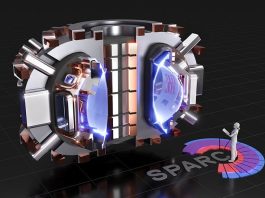The United Kingdom Atomic Energy Authority (UKAEA) has awarded 13 organisations with contracts to develop robust sensing technologies for use in future fusion power plants.
Worth £3.5m in total, 16 contracts – feasibility studies from £100,000 up to £250,000 – have been awarded by UKAEA’s Fusion Industry Programme, an initiative launched in 2021 to develop the necessary technology and skills for future global fusion power plants.
Ten private companies and three academic institutions are developing a range of sensing and diagnostic technologies for use in extreme environments, an essential field of innovation for future fusion plants.
The role of sensing technologies in fusion power plants
Fusion power plants will operate under complex conditions, including extreme temperatures, high neutron loads and high magnetic fields.
Developing highly specialised, robust sensing and control technologies that can operate under these extreme conditions is essential to making fusion energy a commercially viable part of the world’s energy mix.
Novel sensing and diagnostic systems will be needed to measure a range of data within a fusion power plant, including plasma position and shape, plasma electron density, temperature, and the performance of plasma-facing components.
The 13 organisations will now undertake technical feasibility studies, taking their sensing and diagnostics technologies to ‘proof of concept’ stages with support from the Fusion Industry Programme.
Expert support from the Fusion Industry Programme
In a first for the Fusion Industry Programme, expert fusion industry support is being provided by technical advisors from both UKAEA and Tokamak Energy Ltd.
Experts from UKAEA and Tokamak Energy are providing technical advice on the conditions encountered in a fusion environment to help inform the design and development of sensing and diagnostic technologies.
Tim Bestwick, Chief Technology Officer and Deputy CEO, UKAEA, explained: “Fusion promises to be a safe, sustainable source of energy for future generations. However, delivering fusion means overcoming complex scientific and engineering challenges, such as developing tough sensors to withstand the harsh environments of fusion power plants.
“The Fusion Industry Programme is engaging private companies and academia to help solve these challenges while stimulating innovation that can boost adjacent sectors.”
Which projects received funding?
The full list of organisations awarded contracts and their project titles are:
- 3 – Sci Ltd: High field, high temperature, radiation-tolerant distributed magnetic sensing feasibility
- Amentum Clean Energy Ltd: Determination of Hydrogen Isotopologues in Liquid Lithium
- First Light Fusion Ltd: Prototyping a multi-use Photon Doppler Velocimetry (PDV) system for robust, remote measurement of inertial fusion compression, power plant relevant electron density measurements and vacuum chamber wall shock movement
- Fraunhofer UK Research Ltd: LED-based Raman spectroscopy analyser for tritium and deuterium concentration measurements; Zeeman Magnetometry for Plasma diagnostics (ZeeMaP); PULSE Phase-sensitive dUaL-comb SpEctrometer for plasma density measurements
- Full Matrix Ltd: A feasibility study for the interpretation of ultrasonic guided waves in witness specimens for remote fusion diagnostics.
- IDOM UK Ltd: AI-Driven Restoration and Monitoring Framework for Plasma-Facing Mirrors in Fusion Diagnostics
- Kyoto Fusioneering UK Ltd: Exploratory Study for the Development of Tritium Concentration Sensors in Application to liquid Lithium and FLIBE under real fusion environment
- MuWave Ltd: Feasibility Study for High Frequency Collective Thompson Scattering System
- Nascent Semiconductor Ltd: Robust Electronics for Sensing Characteristics in Unconventional Environments (RESCUE)
- Oxford Sigma Ltd: Project PRISM – Performance and Resilience of Innovative Surfaces for Mirrors; Project DEPARTED (Diagnostic Erosion Passive and Analysis in Real-Time and Environment Device)
- University of Edinburgh: Development of a Raman Spectroscopic System for the Online Monitoring of Lithium Metal-based Breeding Blankets
- University of Leeds: Terahertz Quantum Cascades Lasers for Plasma Interferometry
- University of Warwick: Diamond Magnetometers for Tokamak Diagnostics
Technologies, ideas and solutions for future fusion development
Joanne Flanagan, Tokamak Energy’s Head of Diagnostics, Data and Control, stated: “We’re delighted to see a wealth of variety in the innovative responses to this challenge and are excited to support the projects in our role as technical advisors.
“Measurement systems and components will need to be extremely robust to operate in the extreme fusion power plant environment, which is why we must explore a full range of technologies, ideas and solutions.”
She concluded: “This challenge is designed to stimulate the innovation needed to address this development, bringing us all one step closer to the goal of delivering clean, secure and affordable fusion energy.”









